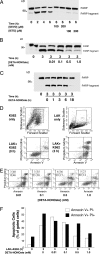Nitric oxide inhibits exocytosis of cytolytic granules from lymphokine-activated killer cells
- PMID: 16857739
- PMCID: PMC1544231
- DOI: 10.1073/pnas.0600275103
Nitric oxide inhibits exocytosis of cytolytic granules from lymphokine-activated killer cells
Abstract
NO inhibits cytotoxic T lymphocyte killing of target cells, although the precise mechanism is unknown. We hypothesized that NO decreases exocytosis of cytotoxic granules from activated lymphocytes. We now show that NO inhibits lymphokine-activated killer cell killing of K562 target cells. Exogenous and endogenous NO decreases the release of granzyme B, granzyme A, and perforin: all contents of cytotoxic granules. NO inhibits the signal transduction cascade initiated by cross-linking of the T cell receptor that leads to granule exocytosis. In particular, we found that NO decreases the expression of Ras, a critical signaling component within the exocytic pathway. Ectopic expression of Ras prevents NO inhibition of exocytosis. Our data suggest that Ras mediates NO inhibition of lymphocyte cytotoxicity and emphasize that alterations in the cellular redox state may regulate the exocytic signaling pathway.
Conflict of interest statement
Conflict of interest statement: No conflicts declared.
Figures






Similar articles
-
Two pathways of exocytosis of cytoplasmic granule contents and target cell killing by cytokine-induced CD3+ CD56+ killer cells.Blood. 1995 Nov 1;86(9):3493-9. Blood. 1995. PMID: 7579455
-
New mechanism of organophosphorus pesticide-induced immunotoxicity.J Nippon Med Sch. 2007 Apr;74(2):92-105. doi: 10.1272/jnms.74.92. J Nippon Med Sch. 2007. PMID: 17507786 Review.
-
Comparison of primary human cytotoxic T-cell and natural killer cell responses reveal similar molecular requirements for lytic granule exocytosis but differences in cytokine production.Blood. 2013 Feb 21;121(8):1345-56. doi: 10.1182/blood-2012-07-442558. Epub 2013 Jan 2. Blood. 2013. PMID: 23287865
-
The mechanism of organophosphorus pesticide-induced inhibition of cytolytic activity of killer cells.Cell Mol Immunol. 2006 Jun;3(3):171-8. Cell Mol Immunol. 2006. PMID: 16893497 Review.
-
Protein tyrosine kinase inhibition blocks granule exocytosis and cytolytic function of lymphokine-activated killer cells.Immunopharmacology. 1996 Nov;35(2):83-102. doi: 10.1016/s0162-3109(96)00115-4. Immunopharmacology. 1996. PMID: 8956972
Cited by
-
VAMP-1, VAMP-2, and syntaxin-4 regulate ANP release from cardiac myocytes.J Mol Cell Cardiol. 2010 Nov;49(5):791-800. doi: 10.1016/j.yjmcc.2010.08.020. Epub 2010 Aug 27. J Mol Cell Cardiol. 2010. PMID: 20801128 Free PMC article.
-
Inflammatory levels of nitric oxide inhibit airway epithelial cell migration by inhibition of the kinase ERK1/2 and activation of hypoxia-inducible factor-1 alpha.J Biol Chem. 2008 Jun 27;283(26):17919-28. doi: 10.1074/jbc.M709914200. Epub 2008 Apr 18. J Biol Chem. 2008. PMID: 18424783 Free PMC article.
-
Nitric oxide regulates non-classical secretion of tissue transglutaminase.Commun Integr Biol. 2011 Sep;4(5):584-6. doi: 10.4161/cib.16512. Epub 2011 Sep 1. Commun Integr Biol. 2011. PMID: 22046470 Free PMC article.
-
Reactive Oxygen Species: Do They Play a Role in Adaptive Immunity?Front Immunol. 2021 Nov 22;12:755856. doi: 10.3389/fimmu.2021.755856. eCollection 2021. Front Immunol. 2021. PMID: 34899706 Free PMC article. Review.
-
Hydrogen sulfide [corrected] increases survival during sepsis: protective effect of CHOP inhibition.J Immunol. 2014 Feb 15;192(4):1806-14. doi: 10.4049/jimmunol.1300835. Epub 2014 Jan 8. J Immunol. 2014. PMID: 24403532 Free PMC article.
References
Publication types
MeSH terms
Substances
Grants and funding
- P01 HL56091/HL/NHLBI NIH HHS/United States
- HL70929/HL/NHLBI NIH HHS/United States
- P01 HL065608/HL/NHLBI NIH HHS/United States
- P01 HL056091/HL/NHLBI NIH HHS/United States
- HL72518/HL/NHLBI NIH HHS/United States
- P01 HL65608/HL/NHLBI NIH HHS/United States
- R01 HL63706/HL/NHLBI NIH HHS/United States
- U01 HL072518/HL/NHLBI NIH HHS/United States
- R56 HL070929/HL/NHLBI NIH HHS/United States
- R01 HL074061/HL/NHLBI NIH HHS/United States
- R01 HL063706/HL/NHLBI NIH HHS/United States
- R01 HL070929/HL/NHLBI NIH HHS/United States
LinkOut - more resources
Full Text Sources
Research Materials

